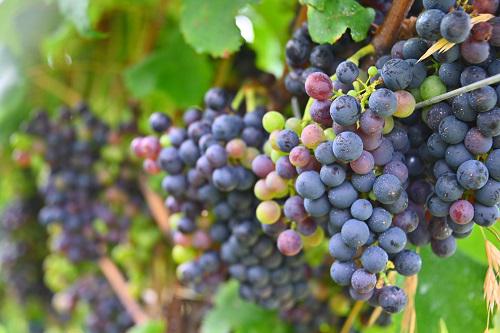サントリー ワイン スクエア
- ワインスクエアTOP
- Wataru Report
- 登美の丘ワイナリーでぶどうの収穫体験をしてまいりました!
岩田 渉(いわた わたる)プロフィール
1989年愛知県生まれ。同志社大学在学中、留学先のニュージーランドでワインに魅了され、2014年にソムリエ資格を取得。2017年「第8回全日本最優秀ソムリエコンクール」優勝。2018年「第4回A.S.I.アジア・オセアニア最優秀ソムリエコンクール」優勝。2019年よりサントリーワイン・ブランドアンバサダー。京阪グループのフラッグシップホテルTHE THOUSAND KYOTOのシェフソムリエを務める。いま日本で最も注目されるソムリエの一人。
登美の丘ワイナリーでぶどうの収穫体験をしてまいりました!
2019.10.18記事: 岩田渉(アンバサダー)

暑く厳しい8月が終わり、ようやく気候も秋らしくなってきました。今年も待ちに待ったぶどうの収穫の季節がやってきたということで、その進行状況などを知るために、9月中旬に山梨県の登美の丘ワイナリーへ訪問してまいりました。前回7月に訪問した際は栽培担当の和田さんのもと、畑でのお仕事をお手伝いさせて頂きましたが、今回も和田さんに色々と学ばせて頂きました。

色づきが進むメルロ
まずは畑を見てビックリ。前回大苦戦した「笠かけ」作業をしたメルロのぶどう畑のヴェレゾン(ぶどうの果皮が色付いていく現象)が終わり、黒々色濃く垂れ下がっているのを見て、この2ヶ月の間でのぶどうの成長に改めて驚きました。普段は街中で暮らしていると、このような大自然の魅力をつい忘れてしまいがちですが、登美の丘に来るたびに、ぶどうや鳥や虫、広大な景色を見てつい童心に帰ってしまいます。

シャルドネの房からサンプル用の小さな房を摘む様子

私もサンプル用にシャルドネを摘ませていただきました
まずは収穫を控えたシャルドネの熟度などを計る、サンプリングの作業を一緒にさせて頂きました。たわわに実ったシャルドネを一粒ずつ手に取りながら、実際にぶどうを食べて収穫のタイミングを把握します。もちろん糖度計などを使い数値としては分析するそうなのですが、あくまでも最後の「GO」サインは人が出します。糖度や酸度だけでなく、皮からもたらされるようなフレーヴァーまで吟味していきます。当然のことなのですが、区画によって、さらにはその一つ一つの木によってもその味は様々。樹齢や台木、土壌、気候、様々な要因が複雑に混じりあい、ぶどうの味わいが構成されます。
このように同じ房から、ジューシーで甘い、梨や桃のような香りがする大きめの粒があったり、キリッとした輪郭のはっきりとした酸の味わいを基調としたシトラス系の香りがする小さい粒があったりと、本当に個性豊かで面白いですね。

色づきが進むカベルネ・ソーヴィニヨン

高畝栽培について説明する栽培担当の和田さん
シャルドネのサンプリングを終えた後は、その他の品種の進行状況なども確認しました。訪問する度に、いつも大きな発見があります。例えば今回、高畝栽培という特殊な方法で栽培されているカベルネ・ソーヴィニヨンのぶどうをテイスティングさせて頂きました。他の区画のものとは一線を画す味わい。糖分と酸のバランスがよく、フルーツの凝縮感が顕著にあり、仄かなスパイスとハーブを思わせる香りが味わいに深みを与えていました。後は時間と共にタンニンがしっかりと熟してくれば、非常に高品質なものが出来るのでは?とワクワクするようなぶどうでした。
高畝栽培は通常の方法より、ぶどうの畝を地上から約80cm盛り上げて造成することによって、地中の水分が抜けやすくなり、 ぶどうに適度なストレスをかけることができます。特にカベルネ・ソーヴィニヨンは成熟期間に入る際に、この水分ストレスがかかることによって、色づきが良くなり、良く熟していきます。こうすることで、他のカベルネ・ソーヴィニヨンよりも早く収穫することが出来るようです。確かに隣の畑を見るとヴェレゾンはまちまちでしたが、こちらは一様にぶどうが黒くなっていました。
また気候変動などの影響で、環境が少しずつ変わってきている中で、それに併せてさらなる可能性を見出すために、様々なぶどう品種を試験的に植え、その成長を見ることにも和田さんは尽力されています。「登美の丘のテロワールとは何か、改めて向き合っています。」という言葉を最後に頂きました。非常に印象的な言葉でした。

栽培の工夫について様々なお話を聞かせていただきました

フランスやイタリアでも、何百年という時間をかけて、先人の方々の類稀な努力によってどんな品種がどんな気候や土壌に合うのか?を追求してきて、今の豊かなワイン産地が築かれています。この登美の丘でもまさしく、和田さんを中心とした栽培チームが、この産地のポテンシャルを最大限に引き出すために、様々なトライアルをされています。「テロワール」というのは、ただ単純にその産地の気候や土壌などを指す言葉ではありません。
それを表現する「人」がいてこそ、初めて成り立つものだと私は信じています。「和田さんもこの登美の丘の素晴らしいテロワールの一部ですよ。」と、そっと心に秘めながら、その真摯に向き合う前向きな姿を見て、私自身もそのテロワールを少しでも多くの方々にお伝えすることができるように、ソムリエとして何ができるのか?それに向き合い、もっともっと頑張ろうと思いました。
紹介した登美の丘ワイナリーのワインの購入はこちら
Hands-on Firm Experience at Tomi No Oka Winery
2019.10.18

The relentlessly hot summer days were coming to an end and Autumn is setting in. The much-awaited harvest season has come. This time again I visited Tomi No Oka Winery in Yamanashi Prefecture to see how harvesting was proceeding in mid-September. In my last visit in July, I was given the opportunity to assist with farm work. This time again I learned more about farm work from Mr. Wada.

Merlot grapes changing colour
I was surprised when I saw the vineyard. Merlot, over which I struggled to put paper umbrellas last time, had gone through Veraison (a phenological stage during which grapes change their colour), darken and hung heavy off the vine. I was amazed at how quickly they grew in less than 2 months. Living in a busy city, we often forget about the beauty of the great nature like this. But every time I come back to Tomi No Oka and see grapes, birds, insects and the magnificent view, I feel like a kid again.

A Chardonnay grape being plucked from a bunch for sampling

Sommelier Iwata is shown picking Chardonnay grapes for sampling
First, I did sampling to gauge the ripeness of Chardonnay which was ready to harvest. They hand-pick fully ripe Chardonnay one by one, taste them and determine when to harvest them. Of course, they use a sugar refractometer and such to measure sugar content, but it is humans who decide whether or not to issue a pass for them. They analyse not only sugar content or acidity level, but also flavours from the skin. Naturally, the flavour varies depending on the zone and the vine. The taste of grapes is affected by various factors, including vine age, rootstock, soil and climate.
Though coming from the same bunch, some are bigger than others, juicy and sweet and have flavours similar to pears or peaches, and some are smaller than others, have a refreshing, high acidity with a citrus flavour. They are all so distinctively unique and interesting.

Cabernet Sauvignon changing colour

Mr. Wada in charge of viticulture explains high-ridge cultivation method
After sampling, I went to check other varieties. There are big discoveries every time I visit here. For example, this time I tasted Cabernet Sauvignon being grown by a certain method. They tasted distinctively different from other grapes. They had a good balance between sugar content and acidity, condensed fruitiness, with a hint of spice and herb that gives a depth to the taste. The grapes have a lot of potential and are expected to be very high-quality grapes when the tannins become fully ripe over time.
As shown in the photo, the grapes are cultivated by a special method, called high-bridge cultivation method. In this method, ridges are built at a height of 80 cm above the ground to allow underground water to easily drain away and apply adequate stress to grapes. Cabernet Sauvignon changes their colour and ripe well if water stress is applied to them before they enter the ripening phase. Doing this allows them to harvest grapes earlier than other Sauvignon. This was certainly true, because grapes in the next field were not fully through Veraison, but the grapes grown in the method were all darken (black) in colour.
To explore further opportunities in the environment that is gradually changing due to climate change, etc., Mr. Wada is making every effort to grow various varieties of grapes on a trial basis and see their growth. At the end, he said, “I am bringing dedication and passion to terroir of Tomi No Oka Winery.” It was a very impressive comment.

Sommelier Iwata and Mr. Wada discussing ideas for improving grape growing

France and Italy have spent hundreds of years trying to figure out what varieties would suit what climate and soil. Tremendous efforts made by past generations created the rich wine-producing regions. Here at Tomi No Oka Winery, too, a viticulture team led by Mr. Wada is trying out various methods to bring out the maximum potential of the region. “Terroir” is not a word that simply refers to the climate and soil of the region.
I believe there must be “someone” to express it. “Mr. Wada is also a part of this great terroir of Tomi No Oka,” I said in my heart, looking at Mr. Wada who has been making a sincere effort and dedication to the region. I determined myself to try hard to determine what I can do as a sommelier and convey “terroir” to a wider audience.




